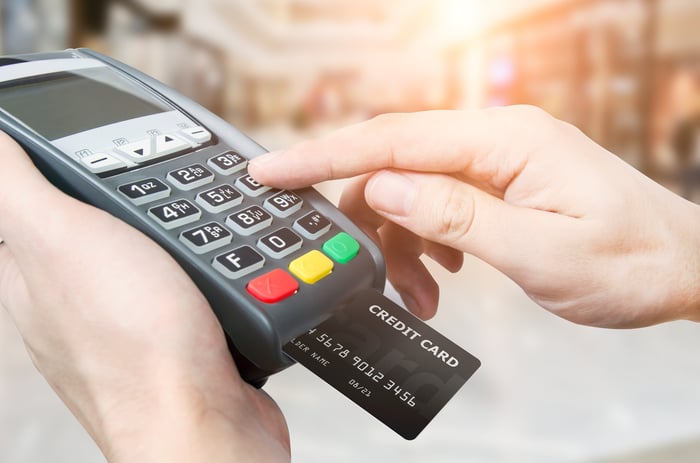While MercadoLibre (MELI -1.79%) is best known as the leader in Latin American e-commerce, it's the company's foray into financial technology (fintech) that will drive the next phase of growth. Mercado Pago, the company's payment system that was originally modeled after PayPal (PYPL 0.64%), has taken the region by storm, not just for online purchases, but for a growing number of brick-and-mortar retailers.
That's not all. The number of customers using its fintech offerings where MercadoLibre operates is skyrocketing, as users opt for its digital payment system, mobile wallet, prepaid cards, and credit services.
MercadoLibre may have gotten its start as an e-commerce platform, but it's the company's fintech that will take center stage moving forward.

Image source: Getty Images.
MercadoLibre showed strong Q4 payments growth
To grasp the magnitude of the growth that is happening, investors need only look to MercadoLibre's fourth-quarter financial report. During the conference call, the company revealed some truly mind-boggling statistics regarding its payments business. Total payment volume (TPV) -- the total amount of payments processed by the company -- rose to $8.7 billion, 63.5% year-over-year growth when translated to U.S. dollars, but up 99% in local currencies. At the same time, the total number of payment transactions increased 127% year over year to 285.5 million.
There were a number of factors that played into those results, but the biggest contributor was off-platform growth. Mercado Pago was originally designed to help customers make online purchases on MercadoLibre's e-commerce platform. Its unbridled success prompted other online retailers to use Mercado Pago as a payment method for their own digital stores, which was then followed by widespread adoption by brick-and-mortar retailers.
MercadoLibre payments business extends beyond the platform
This move off MercadoLibre's platform has supercharged its payments business, as off-platform transactions accounted for 78% of TPV growth. Additionally, off-marketplace TPV represented 55% of the total payments in the fourth quarter, and generated growth of 121%, or 176% year over year in local currencies.
The company's mobile point-of-sale (mPOS) business is contributing to this surge, growing 126% year over year in local currencies. During the year, 3.8 million merchants processed more than 88.5 million transactions on the company's Mercado Pago Point handheld payment devices, generating growth of 160% year over year and 36% sequentially.
An attractive portfolio of products and services
Another factor driving growth is the rapid adoption of its products by consumers. MercadoLibre's mobile wallet is a hit with users, generating TPV of $1.3 billion. In the fourth quarter, the company reached 8 million active payers and 2.4 million active collectors, an increase of 29.4% and 51.6% quarter over quarter, respectively. During 2019, MercadoLibre significantly ramped up distribution of its prepaid cards, which can be linked to consumers' mobile wallet accounts, issuing more than 4.5 million cards since inception. This more than doubled the TPV processed on the cards compared to the same time last year.
Finally, the company lends money to both its merchants and customers via its Mercado Credito service. The company provides working capital and cash advance loans for vendors and has extensive records regarding its merchants and customers -- some going back decades -- giving MercadoLibre unique insight into their creditworthiness. Vendor loans are secured by merchant sales and the company takes a percentage of each sale until the loan is repaid in full. The company also offers installment payments on certain customer purchases.

Image source: Getty Images.
A massive opportunity for MercadoLibre
To understand the magnitude of the MercadoLibre's opportunity, it's worth pointing out that Latin America has historically been a cash-based society and an estimated 70% of the region's 642 million residents are classified as unbanked or underbanked, meaning many don't have a bank account or a credit card.
To overcome this obstacle and enable sales on its e-commerce website, MercadoLibre established an extensive network of convenience stores and other locations that allow customers to add money to their Mercado Pago account, making the company a de facto banker and giving it an edge that competitors simply can't match. The addition of a mobile wallet, prepaid debit cards, mPOS devices, and loan services further cemented MercadoLibre's fintech offerings.
The opportunity in the region is so great, in fact, that it caught the attention of PayPal. Early last year, the company made a $750 million equity investment in MercadoLibre to help accelerate its growth.
Given the growing portfolio of offerings combined with MercadoLibre's extensive reach in the region, it's easy to see why its fintech business is just getting started.





